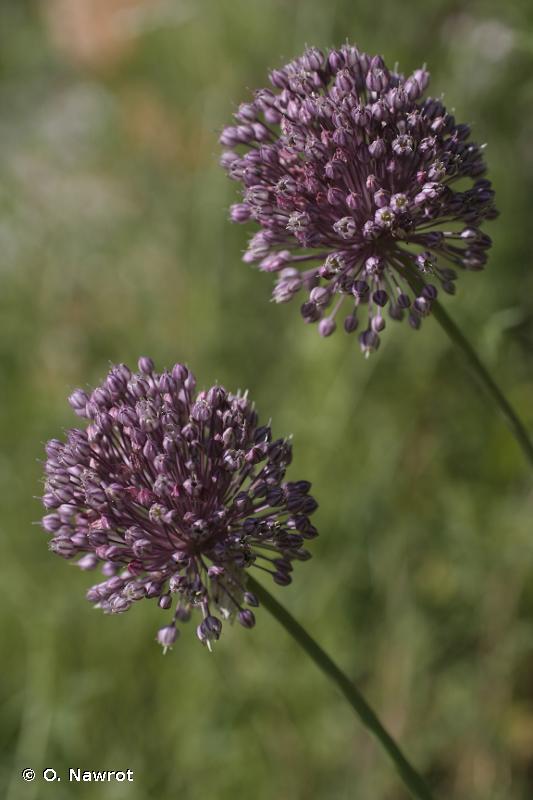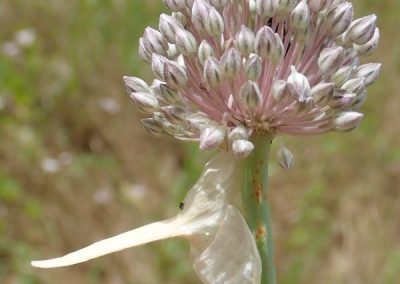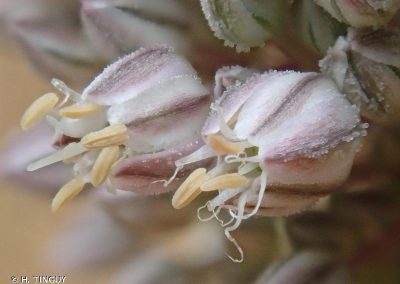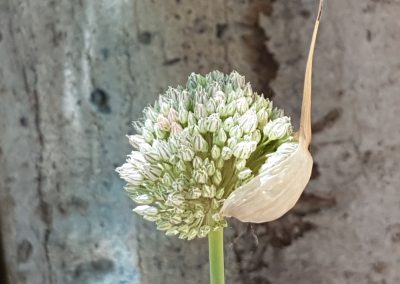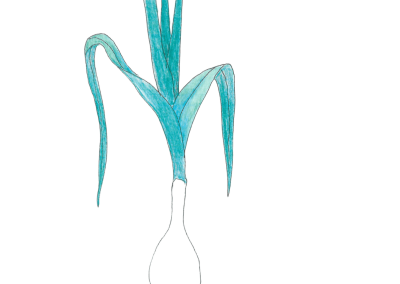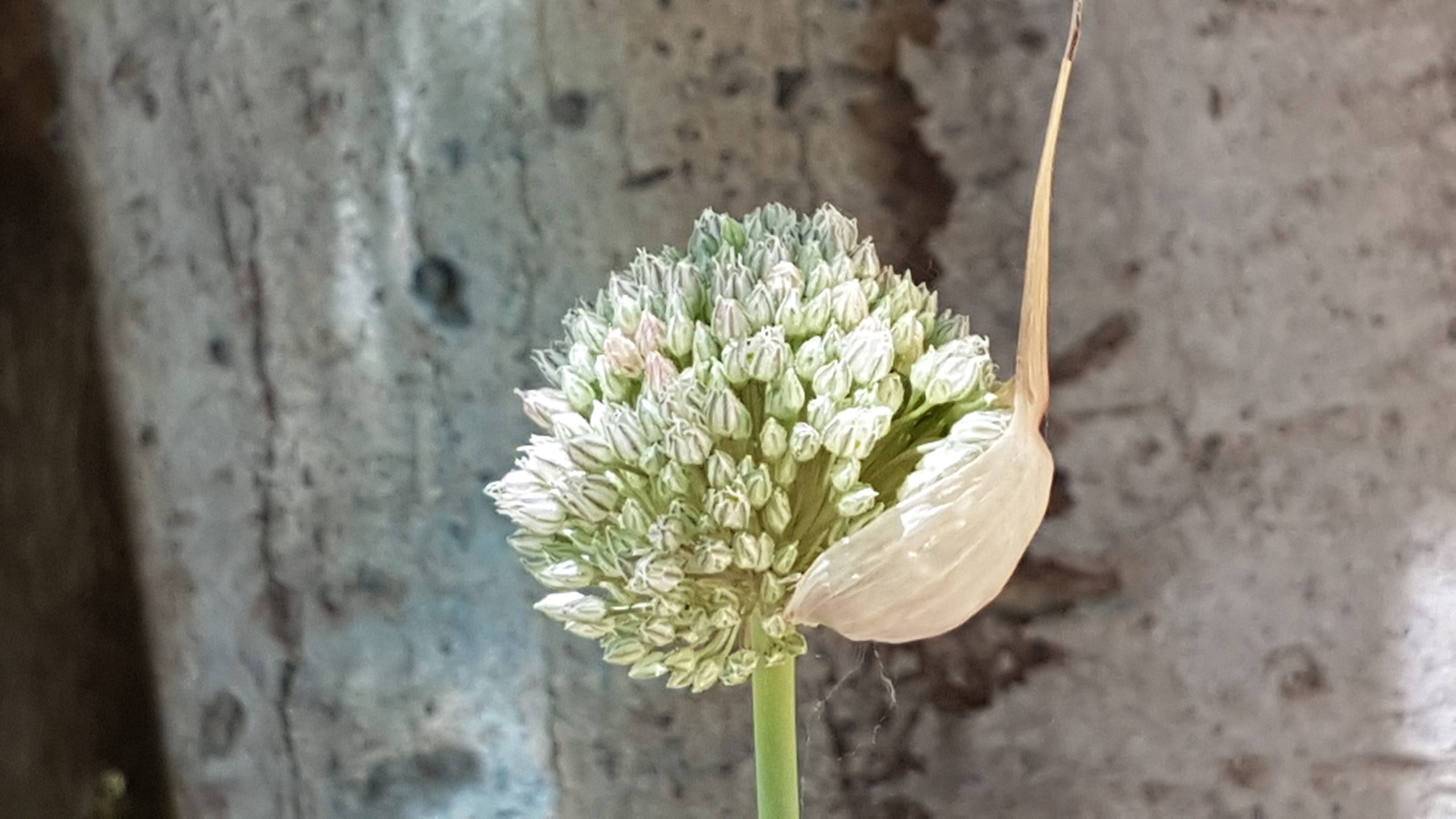Allium Polyanthum
Scientific description
Taxon: Allium polyanthum
Class: Monocotyledonae (Liliopsida)
Subclass: Liliidae
Order: Asparagales
Family: Amaryllidaceae
Common name: Many-flowered garlic
Origin:
Western Mediterranean — native to southern France, eastern Spain, and parts of North Africa (Morocco, Algeria, Tunisia).
Description:
Allium polyanthum, commonly known as wild leek or wild garlic, is a perennial plant that grows 40–80 cm tall. It usually has 2 main bulbs and several bulbils. The thick cylindrical stem bears leaves along its first third. The leaves are alternate, linear, wide, flat, and glabrous.
The flowering period is June–July, producing pink or white flowers in umbels on a long stalk. It resembles cultivated leek and is edible. Found in open habitats across the northern Mediterranean basin. Listed as of least concern nationally, but threatened locally by habitat loss.
Propagation:
Mainly by bulb division in autumn or spring; seed propagation is slower.
Ecology:
Prefers dry, sunny habitats (garrigue, maquis, rocky grasslands). Grows in calcareous, well-drained soils up to 1000 m altitude.
Use:
• Edible young leaves and bulbs (mild garlic flavor)
• Culinary condiment
• Traditional medicine (digestive, antiseptic)
• Occasionally ornamental
Threat:
Locally threatened by urbanization, overgrazing, and overharvesting. Not globally endangered, but may need regional conservation.
Taxon : Allium polyanthum
Classe : Monocotylédones (Liliopsida)
Sous-classe : Liliidae
Ordre : Asparagales
Famille : Amaryllidaceae
Nom commun : Ail à nombreuses fleurs
Origine :
Méditerranée occidentale — sud de la France, est de l’Espagne, Afrique du Nord (Maroc, Algérie, Tunisie).
Description :
Allium polyanthum, aussi appelé ail sauvage ou poireau sauvage, est une plante vivace de 40 à 80 cm de hauteur. Elle possède 2 bulbes principaux et plusieurs bulbilles. La tige, cylindrique et épaisse, porte des feuilles sur son tiers inférieur. Les feuilles sont alternes, larges, plates et glabres.
Floraison en juin–juillet avec fleurs roses ou blanches en ombelle. Proche du poireau cultivé et également comestible. Présent dans des habitats ouverts du nord méditerranéen. Classée « préoccupation mineure », mais localement menacée par la destruction des habitats.
Propagation :
Division des bulbes à l’automne ou au printemps. Semis possible mais plus lent.
Écologie :
Habitats secs et ensoleillés (garrigue, maquis, pelouses rocheuses). Sols calcaires, bien drainés, jusqu’à 1000 m.
Utilisation :
• Feuilles et bulbes comestibles, goût doux d’ail
• Condiment culinaire
• Médecine traditionnelle (digestif, antiseptique)
• Ornementale
Menaces :
Urbanisation, surpâturage, cueillette excessive. Pas en danger globalement, mais conservation locale nécessaire.
Taxon: Allium polyanthum
Clasă: Monocotiledonate (Liliopsida)
Subclasă: Liliidae
Ordin: Asparagales
Familie: Amaryllidaceae
Denumire populară: Usturoi cu multe flori
Origine:
Mediterana de Vest — sudul Franței, estul Spaniei, nordul Africii (Maroc, Algeria, Tunisia).
Descriere:
Allium polyanthum, cunoscut ca praz sau usturoi sălbatic, este o plantă perenă de 40–80 cm înălțime. Are 2 bulbi principali și mai mulți bulbili. Tulpina cilindrică, groasă, are frunze pe treimea inferioară. Frunzele sunt late, plate, fără peri (glabre).
Înflorește în iunie–iulie cu flori roz sau albe în umbrele. Seamănă cu prazul cultivat și este comestibil. Se găsește în habitate deschise din nordul bazinului mediteranean. Clasificată ca „risc scăzut”, dar amenințată local de distrugerea habitatelor.
Înmulțire:
Prin divizarea bulbilor toamna sau primăvara. Semințele dau rezultate mai lente.
Ecologie:
Preferă habitatele uscate și însorite (garigă, maquis, pajiști stâncoase). Soluri calcaroase, bine drenate, până la 1000 m.
Utilizare:
• Frunze și bulbi comestibili, aromă blândă de usturoi
• În gastronomie
• În medicina tradițională (digestiv, antiseptic)
• Ca plantă ornamentală
Amenințări:
Urbanizare, pășunat excesiv, recoltare necontrolată. Nu este periclitat global, dar necesită protecție regională.
Ταξινόμηση: Allium polyanthum
Κλάση: Μονοκοτυλήδονα (Liliopsida)
Υποκλάση: Liliidae
Τάξη: Asparagales
Οικογένεια: Amaryllidaceae
Κοινό όνομα: Σκόρδο με πολλά άνθη
Περιγραφή:
Το Allium polyanthum, γνωστό ως άγριο πράσο ή άγριο σκόρδο, είναι πολυετές φυτό ύψους 40–80 εκ. Έχει 2 βολβούς και αρκετούς μικρότερους βολβίσκους. Ο παχύς κυλινδρικός βλαστός φέρει φύλλα στο κατώτερο τρίτο του. Τα φύλλα είναι εναλλάξ, γραμμικά, πλατιά, λεία και άτριχα.
Ανθίζει Ιούνιο–Ιούλιο με ροζ ή λευκά άνθη σε σκιάδιο. Μοιάζει με το καλλιεργούμενο πράσο και είναι εδώδιμο. Εντοπίζεται σε ανοιχτά ενδιαιτήματα του βορείου μεσογειακού τόξου. Θεωρείται «ελάχιστης ανησυχίας» στη κόκκινη λίστα, αλλά απειλείται τοπικά.
Πολλαπλασιασμός:
Κυρίως με διαίρεση βολβών το φθινόπωρο ή την άνοιξη. Η σπορά είναι πιο αργή.
Οικολογία:
Ξηρά, ηλιόλουστα περιβάλλοντα (φρύγανα, μακί, πετρώδεις λόφοι). Ασβεστολιθικά, καλά στραγγιζόμενα εδάφη, έως 1000 μ.
Χρήσεις:
• Νεαρά φύλλα και βολβοί εδώδιμοι (ήπια γεύση σκόρδου)
• Στη μαγειρική
• Στη λαϊκή ιατρική (πεπτικά, αντισηπτικά)
• Καλλωπιστικό
Απειλές:
Αστικοποίηση, υπερβόσκηση, υπερσυλλογή. Όχι παγκόσμια απειλούμενο, αλλά απαιτείται τοπική προστασία.
Creative writing inspired by Allium Polyanthum
Enzo the wild leek
Once upon a time, there was a leek named Enzo. The leek was so different from his other friends in that he was sociable and loved to travel. One day, Enzo decided to leave the vegetable garden to go and live new adventures in another vegetable garden in the region. But he soon realized that in this garden there were only leeks. However, the leek couldn't feel at ease because he wanted to impose his own rules on the leeks, who didn't agree.
The next day, Enzo couldn't find a place to sleep, so he spent the night with the leeks. That's how he met Sabrina, one of the most beautiful leeks in the garden. They got to know each other and soon decided to start a vegetable garden and live together. Some time later, Sabrina noticed that Enzo was very distant from her and began to wonder. One day, Sabrina received a rather strange visitor, but suspected nothing. It was Doudoute, a leek from the vegetable garden. After a few hours of revelation, Sabrina was overcome by sadness and couldn't understand why Enzo had deceived her.
When Enzo returned to the vegetable garden and saw Sabrina in this state of deep sadness, he rushed to her and asked what had happened. Sabrina told him, and he soon realized that she had known the whole story. Sabrina decided to leave and never see him again. Enzo tried in vain to hold her back, but couldn't, and let her go, unaware that it was the very last time he would see her. After Sabrina's departure, Enzo felt saddened and devastated by the lack of news from her.
Filled with remorse and regret, he sank into alcohol, for his life no longer had any meaning without her. He tried everything to get her back, but couldn't. A year later, Enzo still couldn't get over it, so he decided to cut off all the leek roots in the vegetable garden out of hatred and rage at not being able to get Sabrina back. That's how he came to be known as the Wild Leek.


